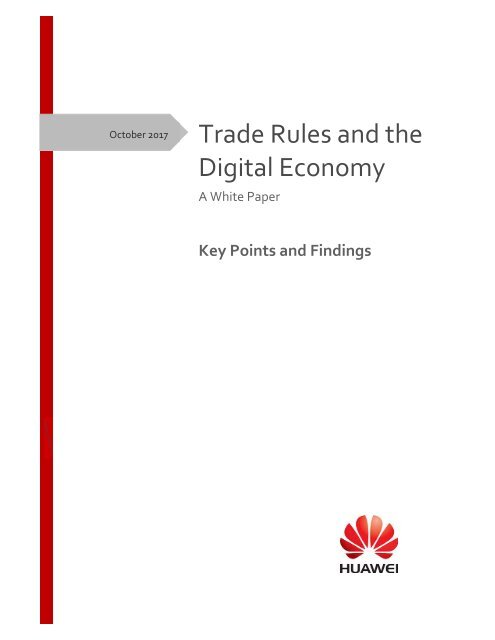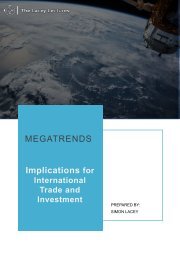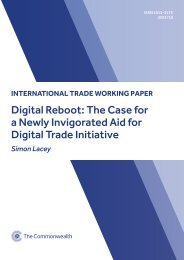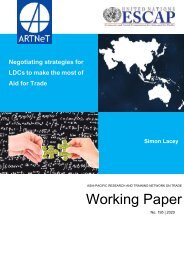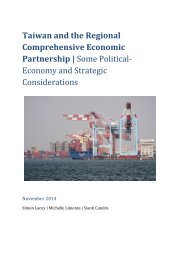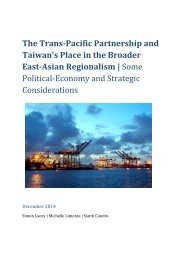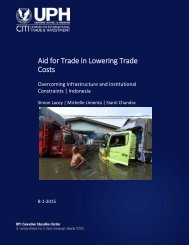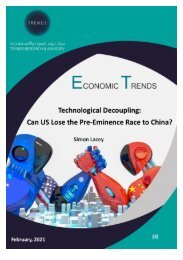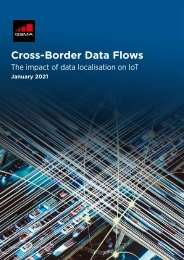White Paper Trade Rules and the Digital Economy Key Points and Findings
This synopsis document summarizes and articulates the key points and findings from the much longer 2017 White Paper on Trade Rules for the Digital Economy.
This synopsis document summarizes and articulates the key points and findings from the much longer 2017 White Paper on Trade Rules for the Digital Economy.
- No tags were found...
Create successful ePaper yourself
Turn your PDF publications into a flip-book with our unique Google optimized e-Paper software.
October 2017<br />
<strong>Trade</strong> <strong>Rules</strong> <strong>and</strong> <strong>the</strong><br />
<strong>Digital</strong> <strong>Economy</strong><br />
A <strong>White</strong> <strong>Paper</strong><br />
<strong>Key</strong> <strong>Points</strong> <strong>and</strong> <strong>Findings</strong>
Huawei | <strong>Trade</strong> <strong>and</strong> <strong>the</strong> <strong>Digital</strong> <strong>Economy</strong><br />
ABSTRACT<br />
Our <strong>White</strong> <strong>Paper</strong> on <strong>Trade</strong> <strong>Rules</strong> <strong>and</strong> <strong>the</strong> <strong>Digital</strong> <strong>Economy</strong> examines trends <strong>and</strong> needs in <strong>the</strong> global digital<br />
economy, <strong>and</strong> <strong>the</strong> emerging set of international trade agreement rules currently under negotiation to<br />
govern world trade in <strong>the</strong> digital economy. It seeks to define <strong>the</strong> needs of <strong>the</strong> global economy, <strong>the</strong><br />
requirements to service those needs by <strong>the</strong> global ICT industry, <strong>and</strong> <strong>the</strong> position of Huawei as a leading ICT<br />
company operating in over 170 countries <strong>and</strong> providing goods <strong>and</strong> services along almost <strong>the</strong> entire length<br />
of <strong>the</strong> global digital value chain. It recommends that non‐discrimination, open markets, <strong>and</strong> fair<br />
competition should be <strong>the</strong> fundamental rules for <strong>the</strong> global digital economy, whereas any exception to<br />
<strong>the</strong>se rules should be adopted subject to <strong>the</strong> principles of transparency, proportionality, necessity, <strong>and</strong><br />
multi‐stakeholder consultation. This short summary of <strong>the</strong> key findings <strong>and</strong> conclusions is provided for<br />
those seeking a more succinct breakdown of our positions on <strong>the</strong>se issues. For a more in‐depth analysis,<br />
please see <strong>the</strong> full <strong>White</strong> <strong>Paper</strong>.<br />
ACKNOWLEDGEMENTS<br />
Huawei’s <strong>White</strong> <strong>Paper</strong> on <strong>Trade</strong> <strong>Rules</strong> <strong>and</strong> <strong>the</strong> <strong>Digital</strong> <strong>Economy</strong> is <strong>the</strong> result of a major project by <strong>the</strong> <strong>Trade</strong><br />
Facilitation <strong>and</strong> Market Access (TFMA) team within Huawei Technologies, inspired by <strong>the</strong> vision of James<br />
K. Lockett, Vice President of <strong>Trade</strong> Facilitation <strong>and</strong> Market Access (TFMA) at Huawei Technologies to stake<br />
out Huawei’s views on <strong>the</strong> pivotal issue of <strong>the</strong> trade rules for <strong>the</strong> digital economy. With contributions from<br />
numerous colleagues, its principal author is Simon Lacey, also at TFMA Huawei Technologies, who<br />
researched <strong>and</strong> prepared an initial <strong>and</strong> comprehensive draft <strong>and</strong> has also edited <strong>the</strong> manuscript through<br />
its various stages. Simon’s tireless commitment to this complex <strong>and</strong> evolving topic is reflected from<br />
beginning to end in <strong>the</strong> <strong>White</strong> <strong>Paper</strong>. It has been written under <strong>the</strong> overall supervision <strong>and</strong> direction of<br />
Madame Chen Lifang, President of PACD at Huawei Technologies <strong>and</strong> Mr. Zhang Jiangang (Victor) as well<br />
as his predecessor Pang Jimin, President of Government Affairs, also at Huawei Technologies. O<strong>the</strong>r<br />
members of <strong>the</strong> TFMA team have also contributed extensive comments <strong>and</strong> edits, <strong>and</strong> thanks must go to<br />
Aless<strong>and</strong>ro Marongiu, Zhang Shige (Aviva), Hu Zhengguo (Neo) <strong>and</strong> Professor Sheng Jianming (Jamie) for<br />
<strong>the</strong>ir input <strong>and</strong> feedback while preparing <strong>the</strong> initial manuscript <strong>and</strong> on many procedural <strong>and</strong> technical<br />
issues in <strong>the</strong> process of bringing <strong>the</strong> <strong>White</strong> <strong>Paper</strong> to fruition. The TFMA team would also like to thank a<br />
number of individuals within Huawei who took time out of <strong>the</strong>ir busy schedules to sit <strong>and</strong> share of <strong>the</strong>ir<br />
valuable insights <strong>and</strong> experience, including in particular Paul Scanlan, Colin Giles, Tommi Laine‐Ylijoki, Joe<br />
Kelly, Walter Jennings, Han Feung, Ting Ka Lun (Allen), Sameer Malik, Zou Wenyu (Kitty) <strong>and</strong> Allan Yap. The<br />
<strong>White</strong> <strong>Paper</strong> has also benefitted enormously from <strong>the</strong> many valuable insights <strong>and</strong> inputs received from<br />
Hosuk Lee‐Makiyama, Martina Francesca Ferracane, <strong>and</strong> Erik van der Marel, with whom <strong>the</strong> TFMA team<br />
worked at <strong>the</strong> end of <strong>the</strong> process to supplement our research <strong>and</strong> add some value in terms of economic<br />
analysis, case studies as well as with graphical inserts. Hosuk’s far‐reaching <strong>and</strong> highly insightful expertise<br />
on <strong>the</strong> subject matter proved extremely valuable. James Lockett <strong>and</strong> Simon Lacey “field tested” some of<br />
<strong>the</strong> preliminary findings at a number of international symposia throughout <strong>the</strong> months <strong>the</strong> <strong>White</strong> <strong>Paper</strong><br />
was being prepared <strong>and</strong> in this context we would like to thank Harsha Singh <strong>and</strong> Michitaka Nakatomi for<br />
comments on an earlier paper for <strong>the</strong> E‐15 initiative which helped our thinking, <strong>and</strong> we must thank Usman<br />
Ahmed from Paypal, Marcos Vaena of <strong>the</strong> International <strong>Trade</strong> Center in Geneva <strong>and</strong> Pierre Sauvé of <strong>the</strong><br />
World Bank for <strong>the</strong>ir valuable contributions as part of our panel session at <strong>the</strong> 2016 WTO Public Forum<br />
which helped our thinking to evolve fur<strong>the</strong>r on <strong>the</strong>se issues. We would also like to thank <strong>the</strong> team of<br />
Huawei translators who worked on <strong>the</strong> Chinese version of <strong>the</strong> <strong>White</strong> <strong>Paper</strong> <strong>and</strong> provided invaluable<br />
assistance in also making <strong>the</strong> English version a much better document. In this regard, it was in particular<br />
<strong>the</strong> skills of Miss Gong Jing that proved invaluable to <strong>the</strong> whole project. Finally we would like to thank Joy<br />
Tan, President of <strong>the</strong> Corporate Communications Department for her invaluable guidance. As always any<br />
shortcomings, errors or omissions in this <strong>White</strong> <strong>Paper</strong> are solely those of <strong>the</strong> lead author.<br />
1
Huawei | <strong>Trade</strong> <strong>and</strong> <strong>the</strong> <strong>Digital</strong> <strong>Economy</strong><br />
EXECUTIVE SUMMARY<br />
Our <strong>White</strong> <strong>Paper</strong> on <strong>Trade</strong> <strong>Rules</strong> for <strong>the</strong> <strong>Digital</strong><br />
<strong>Economy</strong> represents a first attempt by Huawei to<br />
exercise thought leadership in a relatively new<br />
area of international rule‐making. The current set<br />
of international trade rules largely predates <strong>the</strong><br />
internet era of <strong>the</strong> last two decades. An update<br />
of <strong>the</strong> “analogue rules” to bring <strong>the</strong>m into <strong>the</strong><br />
digital age is long overdue but has run into some<br />
unexpected headwinds as of late. Our <strong>White</strong><br />
<strong>Paper</strong> is an attempt to express our views on how<br />
we see <strong>the</strong> current debates surrounding new<br />
trade rules, with <strong>the</strong> hope of making a modest<br />
contribution to producing outcomes that would<br />
guarantee future decades of <strong>the</strong> breathtaking<br />
growth we have seen in <strong>the</strong> digital economy <strong>and</strong><br />
<strong>the</strong> unleashing of pent‐up innovation, as well as<br />
<strong>the</strong> seizing of manifold opportunities as millions<br />
have become empowered in <strong>the</strong> developing<br />
world to set <strong>the</strong>mselves free from poverty.<br />
The first Chapter of our <strong>White</strong> <strong>Paper</strong> defines <strong>the</strong><br />
digital economy as <strong>the</strong> range of goods, products,<br />
services <strong>and</strong> solutions that have emerged <strong>and</strong><br />
continue to emerge in direct relation to online<br />
connectivity. This definition admittedly covers a<br />
broad value chain ranging from <strong>the</strong> hardware<br />
<strong>and</strong> equipment constituting <strong>the</strong> backbone<br />
infrastructure of telecommunications networks,<br />
to <strong>the</strong> devices, particularly smart phones, tablets,<br />
wearables, computers <strong>and</strong> o<strong>the</strong>r terminals used<br />
in order to get <strong>and</strong> stay online. This definition<br />
also comprises <strong>the</strong> various services, solutions<br />
<strong>and</strong> applications that have emerged to meet <strong>the</strong><br />
many needs that users place on <strong>the</strong> internet <strong>and</strong><br />
<strong>the</strong> whole online ecosystem, including digital<br />
products <strong>and</strong> services such as software <strong>and</strong> e‐<br />
books. In laying out this definition, we will look<br />
beyond <strong>the</strong> narrow confines of focusing simply<br />
on e‐commerce, but ra<strong>the</strong>r examine how<br />
digitalization has transformed international<br />
trade across borders: Chapter 1 looks to define<br />
<strong>and</strong> elucidate <strong>the</strong> emergence of modern day<br />
digitalized global value chains that are having a<br />
disruptive <strong>and</strong> transformative effect on both <strong>the</strong><br />
way businesses operate as well as how<br />
consumers acquire <strong>and</strong> use products, services<br />
<strong>and</strong> information.<br />
Chapter 2 of our <strong>White</strong> <strong>Paper</strong> examines Huawei’s<br />
place in <strong>the</strong> digital economy. Across all of our<br />
three business groups, we occupy a unique place<br />
in <strong>the</strong> digital economy in terms of product<br />
coverage, but also in terms of our geographical<br />
footprint, since we operate in both very<br />
underdeveloped as well as very technologically<br />
advanced markets. With regard to our core<br />
carrier business, we are responsible for building<br />
<strong>the</strong> underlying network infrastructure (pipe) that<br />
allows <strong>the</strong> digital economy to function in <strong>the</strong> first<br />
place. When it comes to our enterprise business,<br />
we provide a range of new services <strong>and</strong> solutions<br />
that leverage <strong>the</strong> power of cloud computing <strong>and</strong><br />
remotely serviced platforms, such as in <strong>the</strong> area<br />
of digital customs, or our many Smart City<br />
solutions. Finally in our devices business, where<br />
we are contesting global smartphone, tablet <strong>and</strong><br />
wearables markets, we operate as a seller of <strong>the</strong><br />
terminals with which users interface with <strong>the</strong><br />
digital economy in order to purchase <strong>and</strong>/or<br />
consume <strong>the</strong> services, solutions, products <strong>and</strong><br />
information that <strong>the</strong> digital economy offers. As<br />
such, we are potentially vulnerable to changes in<br />
<strong>the</strong> underlying legal, regulatory <strong>and</strong> policy<br />
regimes that govern <strong>the</strong> many stages of <strong>the</strong><br />
digital value chain. Chapter 2 discusses several<br />
ways in which new <strong>and</strong> existing trade <strong>and</strong><br />
investment rules affect different aspects of our<br />
business.<br />
Chapter 3 focuses on <strong>the</strong> underlying legal <strong>and</strong><br />
regulatory environment in which companies like<br />
Huawei operate. As in many o<strong>the</strong>r fields of <strong>the</strong><br />
law, <strong>the</strong> current rules are struggling to keep pace<br />
with technological developments <strong>and</strong> <strong>the</strong> quick<br />
pace of innovation that characterizes <strong>the</strong><br />
technology sector in particular. Many countries<br />
are enacting rules <strong>and</strong> setting up regulatory<br />
regimes that have a direct impact on <strong>the</strong> digital<br />
economy. Whe<strong>the</strong>r it be with <strong>the</strong> objective of<br />
better protecting <strong>the</strong> data privacy of <strong>the</strong>ir<br />
citizens, beefing up national law enforcement<br />
2
Executive Summary<br />
capabilities in <strong>the</strong> face of increasing cybersecurity<br />
threats, or in <strong>the</strong> hope of kick‐starting<br />
<strong>the</strong>ir own domestic ICT industries, governments<br />
in many countries, both developed <strong>and</strong><br />
developing are becoming increasingly<br />
interventionist in this sector. Chapter 3 analyzes<br />
a number of <strong>the</strong>se policy <strong>and</strong> regulatory trends<br />
<strong>and</strong> discusses how <strong>the</strong>y fit into <strong>the</strong> broader<br />
international consensus that has emerged over<br />
<strong>the</strong> last two decades with respect to global<br />
internet governance <strong>and</strong> rules on <strong>the</strong> digital<br />
economy.<br />
Chapter 4 of our <strong>White</strong> <strong>Paper</strong> focuses on <strong>the</strong><br />
existing <strong>and</strong> emerging set of multilateral <strong>and</strong><br />
preferential trade rules that currently or may<br />
soon govern <strong>the</strong> digital economy. International<br />
rules for digital trade currently exist in a legal<br />
framework put in place before <strong>the</strong> advent of <strong>the</strong><br />
internet era so that we currently live in a world<br />
of “analog rules” for a digital age. As in most<br />
policy areas, international rule‐making tends to<br />
lag behind domestic legislative <strong>and</strong> regulatory<br />
responses to <strong>the</strong> needs of <strong>the</strong> digital economy.<br />
This disconnect is something that had begun to<br />
be addressed in a series of free trade agreement<br />
negotiations, particularly <strong>the</strong> Trans‐Pacific<br />
Partnership (TPP) Agreement <strong>and</strong> <strong>the</strong> Trans‐<br />
Atlantic <strong>Trade</strong> <strong>and</strong> Investment Partnership (TTIP)<br />
‐ both of which face an uncertain future at <strong>the</strong><br />
time of writing. International trade agreement<br />
texts that relate directly to <strong>the</strong> digital economy<br />
are also emerging in <strong>the</strong> context of <strong>the</strong> <strong>Trade</strong> in<br />
Services Agreement (TiSA) negotiations<br />
proceeding on <strong>the</strong> sidelines of <strong>the</strong> WTO, as well<br />
as in <strong>the</strong> context of <strong>the</strong> ASEAN+6 Regional<br />
Economic Partnership (RCEP) negotiations. In<br />
addition to <strong>the</strong>se initiatives, work has been<br />
completed at <strong>the</strong> WTO to update <strong>the</strong> 1997<br />
Information Technology Agreement (ITA) to<br />
bring a whole range of new products within its<br />
scope <strong>and</strong> <strong>the</strong> ITA Committee at <strong>the</strong> WTO is now<br />
seen as a key way of advancing liberalization of a<br />
whole range of non‐tariff barriers (NTBs) that<br />
effect trade in IT products. Finally, o<strong>the</strong>r<br />
initiatives on <strong>the</strong> protection of data <strong>and</strong> on<br />
privacy that are taking place between <strong>the</strong> United<br />
States <strong>and</strong> <strong>the</strong> European Union, as well as earlier<br />
work in <strong>the</strong> OECD <strong>and</strong> APEC, promise to set new<br />
st<strong>and</strong>ards that will affect <strong>the</strong> cross‐border<br />
transfer of personal information <strong>and</strong> as such<br />
have important ramifications for <strong>the</strong> digital<br />
economy. Chapter 4 of our <strong>White</strong> <strong>Paper</strong> explains<br />
<strong>the</strong> current rules framework, <strong>and</strong> addresses<br />
some of <strong>the</strong>se processes <strong>and</strong> <strong>the</strong> substantive<br />
rules that are emerging in this context, while also<br />
looking forward to <strong>the</strong> next WTO Ministerial<br />
Conference in Buenos Aires in December 2017<br />
<strong>and</strong> what a reinvigorated WTO Work Program on<br />
E‐commerce may look like.<br />
Chapter 5, <strong>the</strong> final chapter in our <strong>White</strong> <strong>Paper</strong>,<br />
outlines what an optimal framework for <strong>the</strong><br />
digital economy could look like, namely one that<br />
is characterized by a level playing field <strong>and</strong> nondiscriminatory<br />
access to commercial<br />
opportunities in a spirit of fair <strong>and</strong> open<br />
competition. It also addresses <strong>the</strong> importance of<br />
global investment rules <strong>and</strong> trade in achieving<br />
<strong>the</strong> goal of bridging <strong>the</strong> digital divide. It <strong>the</strong>n<br />
discusses how <strong>the</strong> domestic policy frameworks<br />
<strong>and</strong> corresponding international trade<br />
agreement rules can be formulated <strong>and</strong><br />
implemented in such a way that both meets<br />
reasonable regulatory objectives <strong>and</strong> does not<br />
act as a disguised restriction on international<br />
trade, or in a manner which unfairly favors one<br />
set of (domestic) industry players at <strong>the</strong> expense<br />
of ano<strong>the</strong>r. This Chapter discusses <strong>the</strong> potential<br />
benefits of rules that enable innovation, that<br />
encourage deployment of ICT solutions in order<br />
to bridge existing digital divides, that promote<br />
technology neutrality, an open internet, as well<br />
as flexible <strong>and</strong> compliant approaches to<br />
increasing domestic value‐add requirements.<br />
Finally this Chapter makes a set of compelling<br />
policy <strong>and</strong> economic arguments in favor of <strong>the</strong><br />
positions taken.<br />
We hope our <strong>White</strong> <strong>Paper</strong> will make a<br />
constructive <strong>and</strong> welcome contribution to <strong>the</strong><br />
debate at a time when <strong>the</strong> openness of <strong>the</strong> digital<br />
economy that we have all become accustomed to<br />
could be under threat <strong>and</strong> at a time when <strong>the</strong><br />
positive welfare enhancing effects of trade <strong>and</strong><br />
investment liberalization we have all benefitted<br />
from under <strong>the</strong> post WWII economic order has<br />
started to be challenged in much of <strong>the</strong><br />
developed world.<br />
3
Huawei | <strong>Trade</strong> <strong>and</strong> <strong>the</strong> <strong>Digital</strong> <strong>Economy</strong> | <strong>White</strong> <strong>Paper</strong> <strong>Key</strong> <strong>Points</strong> <strong>and</strong> <strong>Findings</strong><br />
CHAPTER ONE | DEFINING THE DIGITAL ECONOMY AND DIGITAL TRADE<br />
In <strong>the</strong> <strong>White</strong> <strong>Paper</strong> we define <strong>the</strong> digital economy as <strong>the</strong> range of goods, products, services <strong>and</strong><br />
solutions that have emerged <strong>and</strong> continue to emerge in direct relation to online connectivity. This<br />
definition admittedly covers a broadly conceived value chain ranging from <strong>the</strong> hardware <strong>and</strong><br />
equipment constituting <strong>the</strong> backbone infrastructure of <strong>the</strong> internet, to <strong>the</strong> devices, particularly smart<br />
phones, tablets, wearables, computers <strong>and</strong> o<strong>the</strong>r terminals that users avail <strong>the</strong>mselves of in order to<br />
get <strong>and</strong> stay online. This definition also comprises <strong>the</strong> various services, solutions <strong>and</strong> applications that<br />
have emerged to meet <strong>the</strong> multitude of needs that users place on <strong>the</strong> internet <strong>and</strong> <strong>the</strong> whole online<br />
ecosystem, including digital products <strong>and</strong> services such as software <strong>and</strong> e‐books. In laying out this<br />
definition, we look beyond <strong>the</strong> narrow confines of focusing simply on e‐commerce, <strong>and</strong> how<br />
digitalization has changed international trade across borders to define <strong>and</strong> elucidate <strong>the</strong> emergence<br />
of modern day digitalized global value chains that are having a disruptive <strong>and</strong> transformative effect on<br />
both <strong>the</strong> way businesses operate as well as how consumers acquire <strong>and</strong> use products, services <strong>and</strong><br />
information.<br />
<strong>Key</strong> <strong>Points</strong> Summarized<br />
4
Chapter One | Defining <strong>the</strong> <strong>Digital</strong> <strong>Economy</strong><br />
<strong>Key</strong> <strong>Points</strong> Explained<br />
01<br />
When we think of <strong>the</strong> digital economy, most of us tend to think about e‐commerce, since<br />
this is <strong>the</strong> most visible <strong>and</strong> certainly one of <strong>the</strong> most dynamic areas of <strong>the</strong> digital economy.<br />
However <strong>the</strong> digital economy is much more than simply <strong>the</strong> act of providing or consuming<br />
a service online or buying or selling something over <strong>the</strong> internet. In our <strong>White</strong> <strong>Paper</strong> we have defined <strong>the</strong><br />
digital economy as “The ecosystem comprising goods, products, services, platforms <strong>and</strong> solutions that are<br />
ei<strong>the</strong>r instrumental to or avail <strong>the</strong>mselves of online connectivity”.<br />
By <strong>the</strong> same token digital trade is a lot more than international e‐commerce, but comprises – for <strong>the</strong> sake<br />
of this <strong>White</strong> <strong>Paper</strong> – <strong>the</strong> “cross‐border supply of goods, products, services <strong>and</strong> solutions that are<br />
instrumental to or avail <strong>the</strong>mselves of online connectivity”.<br />
In light of <strong>the</strong>se definitions, <strong>the</strong> digital economy <strong>and</strong> digital trade encompass a whole range of goods <strong>and</strong><br />
services, including <strong>the</strong> underlying backbone infrastructure, <strong>the</strong> services provided on top of this<br />
infrastructure, <strong>the</strong> platforms <strong>and</strong> eco‐systems designed to provide a range of goods <strong>and</strong> services using <strong>the</strong><br />
connectivity this infrastructure provides, <strong>and</strong> finally <strong>the</strong> devices or terminals with which <strong>the</strong> user interfaces<br />
with all of this functionality. Accordingly, international trade negotiations that seek to provide new rules<br />
for how governments may regulate trade in <strong>the</strong> digital economy will go beyond <strong>the</strong> narrow issue of e‐<br />
commerce. Instead, <strong>the</strong>y will also embrace disciplines on technical barriers to trade, on <strong>the</strong> cross‐border<br />
supply of services, on trade‐related intellectual property rights, on regulatory cooperation, privacy,<br />
cybersecurity, online payments <strong>and</strong> a whole range of o<strong>the</strong>r related issues, including national security, which<br />
are beyond <strong>the</strong> purview of a single national regulator or ministry.<br />
The digital economy is becoming so ubiquitous <strong>and</strong> all‐encompassing that soon it will be<br />
02 very hard to draw <strong>the</strong> line between <strong>the</strong> digital <strong>and</strong> <strong>the</strong> non‐digital or conventional economy.<br />
The digital economy is quickly simply becoming “<strong>the</strong> economy” This is because digitization<br />
as a trend is quickly taking hold across all sectors of <strong>the</strong> economy <strong>and</strong> permeating all areas of economic<br />
activity. There is an increasing degree of complementarity between off‐line <strong>and</strong> online activities, which is<br />
ano<strong>the</strong>r factor driving this trend. This “convergence” as it is known, must also be reflected in <strong>the</strong> next<br />
generation of international trade rules, so that disciplines are not crafted in silos but ra<strong>the</strong>r take into<br />
account <strong>the</strong>ir potential impact on o<strong>the</strong>r areas of <strong>the</strong> digital <strong>and</strong> offline economies.<br />
The digital economy <strong>and</strong> <strong>the</strong> technological breakthroughs that heralded it have proven to<br />
03 be a watershed for productivity, innovation <strong>and</strong> economic growth, with hi<strong>the</strong>rto<br />
inconceivable new products <strong>and</strong> services being offered creating unparalleled welfare gains<br />
for millions of internet users. These very positive effects from <strong>the</strong> growth of <strong>the</strong> online economy are things<br />
that many policymakers can <strong>and</strong> should foster by carefully considered policy interventions. There are many<br />
things regulators can do to ensure that <strong>the</strong>ir economies share in <strong>the</strong> substantial new growth opportunities<br />
that <strong>the</strong> digital economy offers, many of which start in how <strong>the</strong>y regulate <strong>and</strong> promote <strong>the</strong> availability of<br />
offline factors such as skills, transport <strong>and</strong> connectivity infrastructure, logistics <strong>and</strong> <strong>the</strong> ease of doing<br />
business.<br />
Connectivity infrastructure is a basic precondition for participation in <strong>the</strong> digital economy<br />
04 although it is not <strong>the</strong> only one. Never<strong>the</strong>less, without <strong>the</strong> backbone infrastructure to carry<br />
<strong>the</strong> data produced from <strong>the</strong> interaction between providers <strong>and</strong> consumers, sellers <strong>and</strong><br />
buyers, suppliers <strong>and</strong> users in <strong>the</strong> digital economy, <strong>the</strong>re would be no digital economy to start with. Here<br />
also, <strong>the</strong>re are different policy interventions governments <strong>and</strong> regulators can contemplate <strong>and</strong> enact in<br />
order to boost <strong>the</strong> attractiveness of <strong>the</strong>ir own markets for those that invest in, build <strong>and</strong> operate <strong>the</strong><br />
network infrastructure required to power <strong>the</strong> digital economy, particularly operators.<br />
5
Huawei | <strong>Trade</strong> <strong>and</strong> <strong>the</strong> <strong>Digital</strong> <strong>Economy</strong> | <strong>White</strong> <strong>Paper</strong> <strong>Key</strong> <strong>Points</strong> <strong>and</strong> <strong>Findings</strong><br />
Defining <strong>the</strong> <strong>Digital</strong> <strong>Economy</strong> <strong>and</strong> <strong>Digital</strong> <strong>Trade</strong><br />
As part of our analysis we performed a mapping exercise of <strong>the</strong> various aspects of <strong>the</strong> digital economy as<br />
well as <strong>the</strong> economic actors who populate <strong>and</strong> compete against one ano<strong>the</strong>r across <strong>the</strong> different parts of<br />
<strong>the</strong> digital value chain. See <strong>the</strong> full‐length <strong>White</strong> <strong>Paper</strong> for more in‐depth analysis. Below (figure 1.1) we<br />
show a schematic synopsis of our analysis. Below we have also laid out <strong>the</strong> definitions of both <strong>the</strong> digital<br />
economy <strong>and</strong> digital trade that we have been guided by when writing our <strong>White</strong> <strong>Paper</strong>.<br />
Figure 1:2: The digital economy: Infrastructure, services, platforms/ecosystems <strong>and</strong> devices<br />
1 Infrastructure 2 Services<br />
3 Platforms & 4 Devices<br />
Ecosystems<br />
What?<br />
> Telecommunications networks<br />
<strong>and</strong> connectivity infrastructure;<br />
> Optical fiber, cables, switches,<br />
signal amplifiers, servers, data<br />
centers, satellites, wireless<br />
base stations, mobile<br />
telephone towers, antennas,<br />
routers, modems, range<br />
extenders <strong>and</strong> o<strong>the</strong>r equipment<br />
that brings connectivity to our<br />
homes, offices <strong>and</strong> devices.<br />
> Information, communications<br />
<strong>and</strong> computing services;<br />
> Comprises everything from<br />
banking to retail to booking <strong>and</strong><br />
paying for travel <strong>and</strong><br />
accommodation, to finding <strong>and</strong><br />
booking someone to clean your<br />
apartment <strong>and</strong> someone else to<br />
take you to your next<br />
appointment.<br />
> The result of multi-device<br />
connectivity, meaning we now<br />
connect to <strong>the</strong> internet with two<br />
or more devices <strong>and</strong> expect<br />
seamless operability;<br />
> Results in a winner-take-all<br />
competitive dynamic where <strong>the</strong><br />
economics of network effects<br />
plays a very important role.<br />
> Traditionally desktops or laptops<br />
> Mobile telephones are portable<br />
super-computers capable of almost<br />
any functionality;<br />
> Wearables (watches headphones)<br />
becoming more prominent,<br />
> Trend moving towards connected<br />
homes, connected cars, connected<br />
factories , IoT <strong>and</strong> <strong>the</strong> Internet of<br />
Everything (ubiquitous <strong>and</strong><br />
comprehensive connectivity).<br />
Who?<br />
> Few large equipment vendors<br />
working with carriers;<br />
> 1000s of smaller players<br />
manufacturing <strong>and</strong> selling<br />
individual components.<br />
> Telcos who invest in build,<br />
operate <strong>and</strong> lease access to<br />
<strong>the</strong>ir networks;<br />
> Millions of o<strong>the</strong>r providers from<br />
Citibank to Uber <strong>and</strong> across<br />
many o<strong>the</strong>r sectors.<br />
> Google <strong>and</strong> Android versus<br />
Apple <strong>and</strong> iOS;<br />
> WeChat <strong>and</strong> Alibaba in China;<br />
> Amazon, Microsoft.<br />
> The future belongs to those<br />
who can make all of <strong>the</strong><br />
devices users want;<br />
> And connect <strong>the</strong>m seamlessly<br />
with ecosystems that <strong>the</strong>y<br />
ei<strong>the</strong>r own or control.<br />
Source: Huawei<br />
The <strong>Digital</strong><br />
<strong>Economy</strong><br />
Defined<br />
The ecosystem comprising<br />
goods, products, services,<br />
platforms <strong>and</strong> solutions that<br />
are ei<strong>the</strong>r instrumental to or<br />
avail <strong>the</strong>mselves of online<br />
connectivity.<br />
The cross‐border supply of<br />
goods, products, services<br />
<strong>and</strong> solutions that are<br />
instrumental to or avail<br />
<strong>the</strong>mselves of online<br />
connectivity.<br />
<strong>Digital</strong> <strong>Trade</strong><br />
Defined<br />
6
Chapter One | Defining <strong>the</strong> <strong>Digital</strong> <strong>Economy</strong><br />
CHAPTER TWO | HUAWEI’S PLACE IN THE DIGITAL ECONOMY<br />
Across all of our three business groups, we occupy a unique place in <strong>the</strong> digital economy in terms of<br />
product coverage, but also in terms of our geographical footprint, since we operate in both very<br />
underdeveloped as well as highly technologically advanced markets. With regard to our core carrier<br />
network business, we are responsible for building <strong>the</strong> underlying network infrastructure (pipe) that<br />
allows <strong>the</strong> digital economy to function in <strong>the</strong> first place. When it comes to our enterprise business, we<br />
provide a range of new services <strong>and</strong> solutions that leverage <strong>the</strong> many advantages of <strong>the</strong> digital<br />
economy to overcome <strong>the</strong> physical constraints of <strong>the</strong> real world by harnessing <strong>the</strong> power of cloud<br />
computing <strong>and</strong> remotely serviced platforms, such as in <strong>the</strong> area of digital customs, or our many Smart<br />
City solutions. Finally in our devices business, where we are contesting global smartphone, tablet <strong>and</strong><br />
wearables markets, we operate as a manufacturer <strong>and</strong> seller of <strong>the</strong> terminals with which users<br />
interface with <strong>the</strong> digital economy, availing <strong>the</strong>mselves of <strong>the</strong> services, solutions, products <strong>and</strong><br />
information that <strong>the</strong> digital economy provides. As such, we are potentially vulnerable to changes in<br />
<strong>the</strong> underlying legal, regulatory <strong>and</strong> policy regimes that govern <strong>the</strong> many stages of <strong>the</strong> digital value<br />
chain. This section will discuss <strong>the</strong> many ways new <strong>and</strong> existing trade <strong>and</strong> investment rules affect<br />
different aspects of our business across <strong>the</strong> three business units.<br />
<strong>Key</strong> <strong>Points</strong> Summarized<br />
7
Huawei | <strong>Trade</strong> <strong>and</strong> <strong>the</strong> <strong>Digital</strong> <strong>Economy</strong> | <strong>White</strong> <strong>Paper</strong> <strong>Key</strong> <strong>Points</strong> <strong>and</strong> <strong>Findings</strong><br />
<strong>Key</strong> <strong>Points</strong> Explained<br />
01<br />
At Huawei we are uniquely placed across a very broad swa<strong>the</strong> of <strong>the</strong> digital economy, selling<br />
equipment <strong>and</strong> network management services to operators, providing cloud computing<br />
services to both operators <strong>and</strong> a range of o<strong>the</strong>r services providers across different industry<br />
verticals, as well as selling devices <strong>and</strong> wearables to consumers. As such, we can claim to be playing from<br />
a position of some strength as we attempt to define <strong>and</strong> articulate our interests, particularly in those<br />
product segments like network equipment <strong>and</strong> devices where we have recently emerged as an industry<br />
leader. Never<strong>the</strong>less, our broad engagement across such a wide range of industry segments also means<br />
<strong>the</strong>re is some potential for misalignments between different customers <strong>and</strong> stakeholders. Because of our<br />
size <strong>and</strong> <strong>the</strong> breadth of our engagement, <strong>the</strong> rule of thumb for us at Huawei will be that what is good for<br />
<strong>the</strong> global ICT industry as a whole will be good for us as a company. This is likewise bound to be true in<br />
areas of international rule making that target trade <strong>and</strong> investment in <strong>the</strong> digital economy.<br />
02<br />
Opinions tend to differ on how profound <strong>the</strong> changes are that have been wrought by <strong>the</strong><br />
digital economy <strong>and</strong> whe<strong>the</strong>r or not we are at <strong>the</strong> end or just <strong>the</strong> very beginning of an age<br />
of new digital innovation. Regardless of where one st<strong>and</strong>s on this particular question, <strong>the</strong><br />
productivity gains <strong>and</strong> <strong>the</strong> welfare‐enhancing innovation we have seen in <strong>the</strong> last 20 years are all too readily<br />
apparent even to casual observers. The powerful capabilities of digitization <strong>and</strong> <strong>the</strong> internet to instantly<br />
reproduce <strong>and</strong> disseminate knowledge at almost zero cost has ushered in far‐reaching <strong>and</strong> often disruptive<br />
changes to a range of industries, especially those whose goods <strong>and</strong> services can be rendered into a series<br />
of ones <strong>and</strong> zeros. This is yet ano<strong>the</strong>r important <strong>and</strong> distinctly unique characteristic of <strong>the</strong> digital economy<br />
that must be taken into account when trying to negotiate new rules to govern international trade in this<br />
space.<br />
03<br />
The digital divide is a very real phenomenon <strong>and</strong> recent research has shown that it is getting<br />
deeper, meaning that <strong>the</strong> disparities in access <strong>and</strong> capabilities (<strong>and</strong> ultimately access to<br />
opportunities in <strong>the</strong> digital economy) between <strong>the</strong> connected <strong>and</strong> <strong>the</strong> unconnected are<br />
widening even as more <strong>and</strong> more people come online in one way or ano<strong>the</strong>r. This is something that many<br />
in <strong>the</strong> international community, including private sector players like Huawei, are working hard to address.<br />
And here also, <strong>the</strong>re may be a role for trade rules, since negotiating outcomes can be harnessed to help<br />
mitigate shortfalls in developing countries on both <strong>the</strong> dem<strong>and</strong> <strong>and</strong> <strong>the</strong> supply side, through instruments<br />
like technical assistance, aid for trade, or concessional loans tied to <strong>the</strong> realization of carefully conceived<br />
<strong>and</strong> articulated targets in trade agreements.<br />
04<br />
At Huawei, like at almost every o<strong>the</strong>r player in <strong>the</strong> digital economy, we are forced to<br />
confront inconsistencies <strong>and</strong> uncertainties in terms of market access <strong>and</strong> <strong>the</strong> treatment we<br />
encounter once we have entered a market. This is unfortunately a reality of doing business<br />
today although internationally negotiated rules <strong>and</strong> recognized best practices can be useful tools in both<br />
fostering predictability <strong>and</strong> creating a level playing field on which Huawei <strong>and</strong> our industry partners can<br />
compete. We see our role here as cooperating with, <strong>and</strong> where called for, advising <strong>and</strong> educating<br />
policymakers on <strong>the</strong> best possible choices for <strong>the</strong>m in terms of achieving <strong>the</strong>ir policy objectives <strong>and</strong><br />
refraining from imposing measures that unnecessarily distort trade or unfairly favor one set of industry<br />
actors to <strong>the</strong> detriment of ano<strong>the</strong>r.<br />
8
Chapter Three | Emerging Policy <strong>and</strong> Regulatory Trends<br />
Huawei’s Place in <strong>the</strong> <strong>Digital</strong> <strong>Economy</strong><br />
What many people don’t realize is that Huawei is a truly international player, meaning we have operations<br />
<strong>and</strong> business interests that span <strong>the</strong> globe. Although we originated in China, today we operate in some 170<br />
countries <strong>and</strong> count employees from some 170 nationalities among our ranks. That’s from <strong>the</strong> perspective<br />
of geography. From <strong>the</strong> perspective of product markets, we also span a very wide spectrum of <strong>the</strong> digital<br />
economy, having started out as a reseller of switches to our current position as industry leader in network<br />
equipment, number two globally in consumer devices, <strong>and</strong> fast‐growing challenger in <strong>the</strong> cloud computing<br />
space. Figure 2.1 (below) depicts Huawei’s presence both geographically <strong>and</strong> on different product markets.<br />
To read more, check out chapter two of <strong>the</strong> full <strong>White</strong> <strong>Paper</strong>.<br />
Figure 2.1: Huawei’s place in <strong>the</strong> digital economy<br />
Source: Huawei<br />
9
Huawei | <strong>Trade</strong> <strong>and</strong> <strong>the</strong> <strong>Digital</strong> <strong>Economy</strong> | <strong>White</strong> <strong>Paper</strong> <strong>Key</strong> <strong>Points</strong> <strong>and</strong> <strong>Findings</strong><br />
CHAPTER THREE | EMERGING POLICY AND REGULATORY TRENDS<br />
The underlying legal <strong>and</strong> regulatory environment in which companies like Huawei operate is struggling<br />
to keep pace with technological developments <strong>and</strong> <strong>the</strong> quick pace of innovation that characterizes this<br />
sector. Many countries are enacting rules <strong>and</strong> setting up regulatory regimes that have a direct impact<br />
on <strong>the</strong> digital economy. Whe<strong>the</strong>r it be with <strong>the</strong> objective of better protecting <strong>the</strong> data privacy of <strong>the</strong>ir<br />
citizens, beefing up national law enforcement capabilities in <strong>the</strong> face of increasing cyber‐security<br />
threats, or in <strong>the</strong> hope of kick‐starting <strong>the</strong>ir own domestic ICT industries, governments in many<br />
countries, both developed <strong>and</strong> developing are becoming increasingly interventionist in this sector.<br />
Chapter Three of our <strong>White</strong> <strong>Paper</strong> analyzes a number of <strong>the</strong>se policy <strong>and</strong> regulatory trends <strong>and</strong> discuss<br />
how <strong>the</strong>y fit into <strong>the</strong> broader international consensus that has emerged over <strong>the</strong> last two decades with<br />
respect to global internet governance <strong>and</strong> emerging trade rules on <strong>the</strong> digital economy.<br />
<strong>Key</strong> <strong>Points</strong> Summarized<br />
10
Chapter Four| International <strong>Trade</strong> Rule‐Making for <strong>the</strong> <strong>Digital</strong> <strong>Economy</strong><br />
<strong>Key</strong> <strong>Points</strong> Explained<br />
01<br />
For <strong>the</strong> first few years as <strong>the</strong> internet was just starting to gain widespread adoption <strong>and</strong><br />
uptake among users in both developed <strong>and</strong> developing countries, governments were often<br />
slow or hesitant to intervene for fear of overplaying <strong>the</strong>ir h<strong>and</strong>s in trying to regulate<br />
something about which <strong>the</strong>y still lacked a detailed underst<strong>and</strong>ing of both its workings <strong>and</strong> its vulnerabilities.<br />
Those days are almost certainly behind us as governments all over <strong>the</strong> world have become cognizant of <strong>the</strong><br />
very real benefits but also of some of <strong>the</strong> latent risks <strong>the</strong> digital economy entails. We find governments of<br />
all ideological bents actively opting to intervene in <strong>the</strong> digital economy in order to achieve a whole range<br />
of policy <strong>and</strong> regulatory outcomes. Because of <strong>the</strong> complementarity effects <strong>and</strong> <strong>the</strong> general<br />
interconnectedness of both <strong>the</strong> online <strong>and</strong> offline economies, <strong>the</strong>se interventions can have unforeseen<br />
consequences far beyond <strong>the</strong> narrow scope in which <strong>the</strong>y were enacted. Governments need to beware of<br />
<strong>and</strong> refrain from regulatory overreach but <strong>the</strong>y must likewise be careful not to allow a policy or legal<br />
vacuum to arise which engenders real risks to <strong>the</strong> future growth of <strong>the</strong> digital economy.<br />
02<br />
In order to avoid any potentially harmful repercussions that may constitute <strong>the</strong> unforeseen<br />
consequences of such policy <strong>and</strong> regulatory interventions, governments should take into<br />
consideration any internationally agreed principles or pre‐existing best practices before<br />
<strong>the</strong>y act. They should also consult widely with a broad array of stakeholders comprising businesses,<br />
consumer groups, <strong>and</strong> public interest groups, <strong>and</strong> make sure any measures <strong>the</strong>y enact are <strong>the</strong> least invasive,<br />
least trade restrictive, but also an effective way to meet <strong>the</strong> intended policy objective. We also advocate<br />
in favor of non‐discriminatory <strong>and</strong> transparent legislative <strong>and</strong> regulatory processes that result in equal <strong>and</strong><br />
fair market access terms for both foreign <strong>and</strong> domestic economic actors.<br />
03<br />
We recognize <strong>the</strong> important role <strong>the</strong> digital economy has to play in helping governments<br />
foster economic development <strong>and</strong> achieve industrial policy goals, as well as in empowering<br />
users to pursue productive <strong>and</strong> satisfying economic livelihoods. When designing policies<br />
that seek to achieve such outcomes, we advocate strongly in favor of flexible regimes that afford<br />
companies as much freedom of action as possible in deciding how <strong>the</strong>y wish to meet any targets or<br />
objectives set. We also favor governments enacting such targets only following a transparent <strong>and</strong> multistakeholder<br />
consultation that allows all affected parties to have <strong>the</strong>ir views heard.<br />
04<br />
We at Huawei have for many years emphasized <strong>the</strong> importance of investment in <strong>the</strong><br />
essential network infrastructure that enables <strong>the</strong> digital economy <strong>and</strong> unleashes all of its<br />
productivity gains <strong>and</strong> welfare‐enhancing effects. This is a prerequisite to tackling <strong>the</strong><br />
digital divide which continues to plague many, particularly <strong>the</strong> poor in developing countries. Although<br />
connectivity infrastructure is only one of several important elements that need to be tackled to resolve this<br />
problem, we contend that it is both <strong>the</strong> starting point <strong>and</strong> <strong>the</strong> conditio sine qua non for effectively <strong>and</strong><br />
finally bringing <strong>the</strong> billions of unconnected online <strong>and</strong> allowing <strong>the</strong>m to participate in this modern day<br />
economic miracle.<br />
11
Huawei | <strong>Trade</strong> <strong>and</strong> <strong>the</strong> <strong>Digital</strong> <strong>Economy</strong> | <strong>White</strong> <strong>Paper</strong> <strong>Key</strong> <strong>Points</strong> <strong>and</strong> <strong>Findings</strong><br />
Emerging Policy <strong>and</strong> Regulatory Trends<br />
As <strong>the</strong> internet economy emerged in <strong>the</strong> second half of <strong>the</strong> 1990s, it was a place largely free of government<br />
intervention, with some commentators pointing to this as one of <strong>the</strong> reasons why it has grown so quickly<br />
<strong>and</strong> was able to become such a powerful economic force. For better or for worse those days are now well<br />
<strong>and</strong> truly behind us, with many governments having long recognized both <strong>the</strong> massive potential but also<br />
<strong>the</strong> risks that <strong>the</strong> digital economy brings with it. Today governments intervene in <strong>the</strong> digital economy in a<br />
number of ways, both directly <strong>and</strong> indirectly, in order to achieve a very wide range of – for <strong>the</strong> most part –<br />
perfectly legitimate <strong>and</strong> commendable policy objectives. The graphic below (Figure 3.1) is an attempt to<br />
map some of <strong>the</strong> different regulatory objectives governments have for intervening in <strong>the</strong> digital economy<br />
as well as some of <strong>the</strong> different regulatory approaches <strong>the</strong>y take. To find out more, see chapter three of<br />
<strong>the</strong> full <strong>White</strong> <strong>Paper</strong>.<br />
Figure 3.1: Different regulatory objectives <strong>and</strong> approaches<br />
Stimulate<br />
competition<br />
Protect existing<br />
jobs<br />
Promote<br />
economic<br />
development<br />
Increase <strong>the</strong> size<br />
of <strong>the</strong> formal<br />
economy<br />
Bridge <strong>the</strong><br />
digital divide<br />
Objectives<br />
Foster<br />
Innovation<br />
Stimulate<br />
economic<br />
growth<br />
Diversify <strong>the</strong><br />
economy<br />
Promote<br />
market<br />
contestability<br />
Create new jobs<br />
Promote digital<br />
Inclusiveness<br />
Enable inclusive<br />
trade<br />
Kick-start<br />
domestic ICT<br />
industry<br />
Prevent base<br />
erosion <strong>and</strong><br />
profit shifting<br />
Attract<br />
investment<br />
Approaches<br />
Light touch<br />
approaches<br />
Generally favored<br />
by advanced<br />
industrial countries<br />
where <strong>the</strong> digital<br />
economy is already<br />
very ubiquitous.<br />
Interventionist<br />
approaches<br />
Generally chosen<br />
by developing<br />
countries with<br />
prominent national<br />
security concerns or<br />
development<br />
agendas.<br />
Industrial<br />
Policy<br />
Generally chosen<br />
by middle-income<br />
developing<br />
countries with <strong>the</strong>ir<br />
own ambitious<br />
plans for <strong>the</strong> digital<br />
economy.<br />
Executive<br />
agency activism<br />
This can be in <strong>the</strong><br />
form of lawsuits to<br />
reign in tax<br />
privileges,<br />
competition<br />
investigations or<br />
o<strong>the</strong>r actions.<br />
Tax breaks/<br />
incentives<br />
These can be used<br />
to ei<strong>the</strong>r attract<br />
investment or<br />
encourage local<br />
content, but often<br />
also lead to market<br />
distortions.<br />
Source: Huawei<br />
12
Chapter Four| International <strong>Trade</strong> Rule‐Making for <strong>the</strong> <strong>Digital</strong> <strong>Economy</strong><br />
CHAPTER FOUR | INTERNATIONAL TRADE RULE‐MAKING FOR THE DIGITAL ECONOMY<br />
As in most policy areas, international rule‐making tends to lag behind domestic legislative <strong>and</strong><br />
regulatory responses to <strong>the</strong> needs of <strong>the</strong> digital economy. This disconnect is something that had begun<br />
to be addressed in a series of free trade agreement negotiations, particularly <strong>the</strong> Trans‐Pacific<br />
Partnership (TPP) Agreement <strong>and</strong> <strong>the</strong> Trans‐Atlantic <strong>Trade</strong> <strong>and</strong> Investment Partnership (TTIP), both of<br />
which face an uncertain future at <strong>the</strong> time of writing. International treaty texts that relate directly to<br />
<strong>the</strong> digital economy were also emerging in <strong>the</strong> context of <strong>the</strong> <strong>Trade</strong> in Services Agreement (TiSA)<br />
negotiations proceeding on <strong>the</strong> sidelines of <strong>the</strong> WTO, <strong>and</strong> currently feature in <strong>the</strong> ASEAN+6 Regional<br />
Economic Partnership (RCEP) negotiations. In addition to <strong>the</strong>se initiatives, work has been completed<br />
at <strong>the</strong> WTO to update <strong>the</strong> 1997 Information Technology Agreement (ITA) to bring a whole range of<br />
new products within its scope <strong>and</strong> <strong>the</strong> ITA Committee at <strong>the</strong> WTO is now seen as a key way of advancing<br />
liberalization of a whole range of non‐tariff barriers that effect trade in IT products. Finally, o<strong>the</strong>r<br />
initiatives on <strong>the</strong> protection of data <strong>and</strong> on privacy that are taking place between <strong>the</strong> United States<br />
<strong>and</strong> <strong>the</strong> European Union, as well as earlier work in <strong>the</strong> OECD <strong>and</strong> APEC, promise to set new st<strong>and</strong>ards<br />
that will affect <strong>the</strong> cross‐border transfer of personal information <strong>and</strong> as such have important<br />
ramifications for <strong>the</strong> digital economy.<br />
<strong>Key</strong> <strong>Points</strong> Summarized<br />
13
Huawei | <strong>Trade</strong> <strong>and</strong> <strong>the</strong> <strong>Digital</strong> <strong>Economy</strong> | <strong>White</strong> <strong>Paper</strong> <strong>Key</strong> <strong>Points</strong> <strong>and</strong> <strong>Findings</strong><br />
<strong>Key</strong> <strong>Points</strong> Explained<br />
01<br />
The WTO Work Program on Electronic Commerce in 1998 initiated a program of reflection<br />
by WTO members on how best to address <strong>the</strong> trade‐related aspects of <strong>the</strong> <strong>the</strong>n nascent<br />
internet economy, <strong>and</strong> focused predominantly on <strong>the</strong> need to negotiate new rules on e‐<br />
commerce. Likewise, <strong>the</strong> recently completed TPP negotiations, <strong>the</strong> outcome of which is uncertain at <strong>the</strong><br />
time of writing, <strong>and</strong> <strong>the</strong> recently stalled TiSA negotiations have also included dedicated provisions intended<br />
to liberalize cross‐border trade in services <strong>and</strong> establish disciplines on e‐commerce. However <strong>the</strong>re are<br />
o<strong>the</strong>r areas <strong>and</strong> rules that affect <strong>the</strong> digital economy that also need to be addressed both at <strong>the</strong> WTO as<br />
well as in free trade agreements. Also at <strong>the</strong> WTO we had some progress very early (in 1997) on an<br />
Information Technology Agreement (ITA, recently updated in 2015) which saw tariffs eliminated on a large<br />
number of IT products among participating WTO members. In <strong>the</strong> TPP we saw a range of new provisions<br />
addressing different aspects of <strong>the</strong> digital economy beyond e‐commerce, such as in <strong>the</strong> chapter on<br />
technical barriers to trade (rules on conformity assessment procedures, encryption <strong>and</strong> electromagnetic<br />
compatibility), as well as a new chapter on regulatory coherence, <strong>and</strong> new disciplines on <strong>the</strong> cross‐border<br />
supply of services. The more holistic approach taken in <strong>the</strong> TPP, although not perfect, is much more suited<br />
to addressing <strong>the</strong> plethora of trade‐related regulatory issues that different actors across <strong>the</strong> very broadranging<br />
value chain that represents <strong>the</strong> digital economy are increasingly encountering. We hope for <strong>and</strong><br />
advocate a similarly broad approach in o<strong>the</strong>r negotiating fora such as <strong>the</strong> WTO <strong>and</strong> RCEP.<br />
02<br />
We view TiSA <strong>and</strong> RCEP as two negotiating fora that could, if we are lucky, see <strong>the</strong><br />
emergence of new rules that would be of enormous benefit to <strong>the</strong> digital economy,<br />
particularly on issues such as cross‐border trade in services <strong>and</strong> e‐commerce for TiSA <strong>and</strong> a<br />
whole range of issues in RCEP including those mentioned above in Point 1. We also would like to express<br />
our support for an ambitious new negotiating agenda at <strong>the</strong> WTO in <strong>the</strong> context of <strong>the</strong> now very mature<br />
Work Program on Electronic Commerce. Also at <strong>the</strong> WTO we would welcome new negotiations, building<br />
on <strong>the</strong> work of <strong>the</strong> ITA, on non‐tariff barriers in <strong>the</strong> IT <strong>and</strong> ITC sectors, especially with respect to technical<br />
regulations that rely on international st<strong>and</strong>ards <strong>and</strong> <strong>the</strong> adoption of an MFN obligation for conformity<br />
assessment procedures (so that if an IT or ITC product is certified in one WTO member it can be exported<br />
to any o<strong>the</strong>r member without fur<strong>the</strong>r testing). Like we have seen for <strong>the</strong> ITA, new rules on non‐tariff<br />
barriers could first be agreed on a plurilateral basis with an open membership clause.<br />
03<br />
We at Huawei have come from very humble beginnings <strong>and</strong> fought many existential battles<br />
to become <strong>the</strong> global industry leader that we are today. Along <strong>the</strong> way we have benefitted<br />
from <strong>the</strong> openness that has characterized much of <strong>the</strong> global economy <strong>and</strong> many of <strong>the</strong><br />
markets in which we have been privileged to serve our customers <strong>and</strong> build relationships with our<br />
stakeholders. This journey has also contributed in no small way to <strong>the</strong> formation <strong>and</strong> streng<strong>the</strong>ning of our<br />
core values <strong>and</strong> guiding principles, which include support for free trade, open <strong>and</strong> fair competition on a<br />
level playing field <strong>and</strong> <strong>the</strong> protection of intellectual property rights. These principles will continue to guide<br />
us <strong>and</strong> we will advocate for <strong>the</strong>m in all <strong>the</strong> markets we do business in, both at home <strong>and</strong> abroad.<br />
04<br />
We also recognize that trade rules can be about more than just trade <strong>and</strong> investment<br />
liberalization or imposing disciplines to curb protectionism. Ra<strong>the</strong>r, we see trade rules <strong>and</strong><br />
<strong>the</strong> market opening that <strong>the</strong>y foster, as also acting to support development outcomes <strong>and</strong><br />
greater inclusion into regional <strong>and</strong> global value chains of small <strong>and</strong> medium sized enterprises, as well as<br />
micro businesses. We favor leveraging existing <strong>and</strong> future trade rules to not only bridge <strong>the</strong> digital divide<br />
but also exp<strong>and</strong> <strong>the</strong> reach of <strong>the</strong> digital economy, to create a more equitable <strong>and</strong> fairer world economic<br />
order where anyone who chooses to participate can. The digital economy has been <strong>the</strong> harbinger of many<br />
benefits <strong>and</strong> all <strong>the</strong> world’s people should be able to partake in <strong>the</strong>se new <strong>and</strong> exciting technologies.<br />
14
Huawei | <strong>Trade</strong> <strong>and</strong> <strong>the</strong> <strong>Digital</strong> <strong>Economy</strong> | <strong>White</strong> <strong>Paper</strong> <strong>Key</strong> <strong>Points</strong> <strong>and</strong> <strong>Findings</strong><br />
International <strong>Trade</strong> Rule‐Making for <strong>the</strong> <strong>Digital</strong> <strong>Economy</strong><br />
As governments have started to intervene more actively in <strong>the</strong> digital economy, different industry players<br />
have sought to lobby <strong>the</strong>ir governments in order to establish international treaty commitments that set<br />
limits on such intervention <strong>and</strong> establish both a level playing field as well as predictable terms of market<br />
access for foreign <strong>and</strong> domestic actors. Governments have also seized <strong>the</strong> opportunity presented by<br />
various new trade negotiating forums to adopt rules <strong>and</strong> enact disciplines that promote international<br />
cooperation <strong>and</strong> a degree of harmonization or at least coherence in this sphere. However, it should not be<br />
overlooked that <strong>the</strong> WTO already governs a large degree of <strong>the</strong> international trade that takes place in <strong>the</strong><br />
digital economy as defined in <strong>the</strong> <strong>White</strong> <strong>Paper</strong>. There remains some contention among WTO members as<br />
to whe<strong>the</strong>r new rules <strong>and</strong> disciplines are even needed. Never<strong>the</strong>less, <strong>the</strong> trend is pointing towards, <strong>and</strong><br />
many industry actors in different parts of <strong>the</strong> digital economy continue to advocate in favor of new rules<br />
to clarify <strong>the</strong>ir freedom of action <strong>and</strong> <strong>the</strong>ir rights in <strong>the</strong> face of increasingly interventionist governments.<br />
See Chapter Four of <strong>the</strong> full <strong>White</strong> <strong>Paper</strong> to learn more.<br />
Figure 4.1: <strong>Trade</strong> <strong>Rules</strong> Old <strong>and</strong> New<br />
15
Chapter Five | A Vision for an Optimal <strong>Trade</strong> Regime for <strong>the</strong> <strong>Digital</strong> <strong>Economy</strong><br />
CHAPTER FIVE | A VISION FOR AN OPTIMAL TRADE REGIME FOR THE DIGITAL ECONOMY<br />
This chapter of <strong>the</strong> <strong>White</strong> <strong>Paper</strong> outlines what an optimal framework for <strong>the</strong> digital economy could<br />
look like, namely one that is characterized by a level playing field <strong>and</strong> non‐discriminatory access to<br />
commercial opportunities in a spirit of fair <strong>and</strong> open competition. It also addresses <strong>the</strong> importance of<br />
global investment rules <strong>and</strong> trade in achieving <strong>the</strong> goal of bridging <strong>the</strong> digital divide. It <strong>the</strong>n discusses<br />
how <strong>the</strong> domestic policy frameworks <strong>and</strong> corresponding international trade agreement rules can be<br />
formulated <strong>and</strong> implemented in such a way that both meet reasonable regulatory objectives <strong>and</strong> do<br />
not act as a disguised restriction on international trade, or in a manner which unfairly favors one set<br />
of industry players to <strong>the</strong> detriment of o<strong>the</strong>rs. Chapter Five also discusses <strong>the</strong> potential benefits of<br />
rules that enable innovation, that encourage deployment of ICT solutions in order to bridge existing<br />
digital divides, that promote technology neutrality, an open internet, flexible <strong>and</strong> compliant<br />
approaches to increasing domestic value‐add requirements among o<strong>the</strong>rs. Finally Chapter Five makes<br />
a set of compelling policy <strong>and</strong> economic arguments in favor of <strong>the</strong> positions taken.<br />
<strong>Key</strong> <strong>Points</strong> Summarized<br />
16
Huawei | <strong>Trade</strong> <strong>and</strong> <strong>the</strong> <strong>Digital</strong> <strong>Economy</strong> | <strong>White</strong> <strong>Paper</strong> <strong>Key</strong> <strong>Points</strong> <strong>and</strong> <strong>Findings</strong><br />
<strong>Key</strong> <strong>Points</strong> Explained<br />
01<br />
As new disciplines start to emerge to govern <strong>the</strong> digital economy across a broad variety of<br />
rule‐making fora, we at Huawei favor enforceable treaty commitments that establish a level<br />
playing field for both domestic <strong>and</strong> foreign firms on <strong>the</strong> one h<strong>and</strong>, but also legacy players<br />
<strong>and</strong> new market entrants on <strong>the</strong> o<strong>the</strong>r. When we enter a new market or as we continue to serve customers<br />
in our existing markets, we need to be able to count on non‐discriminatory treatment across a whole range<br />
of policy <strong>and</strong> regulatory areas, as well as transparency of local laws, regulations, administrative practices<br />
<strong>and</strong> market conditions. Where regulatory intervention is required, we at Huawei favor such intervention<br />
being commensurate to <strong>the</strong> desired policy outcomes <strong>and</strong> in line with international best practices. We also<br />
favor regulators <strong>and</strong> market actors working toge<strong>the</strong>r in a spirit of mutual cooperation to achieve outcomes<br />
that are optimal for both business <strong>and</strong> consumers.<br />
02<br />
We at Huawei recognize <strong>the</strong> need for governments to intervene in markets, including <strong>the</strong><br />
digital economy, for a whole range of perfectly legitimate policy reasons. We support<br />
governments in <strong>the</strong>ir role as <strong>the</strong> ultimate arbiters of <strong>the</strong> public interest <strong>and</strong> in <strong>the</strong>ir<br />
inalienable responsibility to safeguard <strong>the</strong> interests of <strong>the</strong> State <strong>and</strong> its citizens. When governments do see<br />
<strong>the</strong>mselves as required to act, we favor interventions that conform to global best practices <strong>and</strong> that respect<br />
international treaty obligations, including those in trade <strong>and</strong> investment agreements. These interventions<br />
should be minimally trade distorting <strong>and</strong> should not restrict <strong>the</strong> rights of foreign <strong>and</strong> domestic firms beyond<br />
that which is absolutely required. We advocate in favor of business <strong>and</strong> investment governance regimes<br />
which grants all affected parties a chance to share <strong>the</strong>ir views on how best to achieve <strong>the</strong> intended policy<br />
objectives.<br />
03<br />
At Huawei we believe that we must work toge<strong>the</strong>r with our customers, industry partners<br />
<strong>and</strong> government stakeholders to achieve win‐win outcomes that favor <strong>the</strong> continued<br />
robust <strong>and</strong> healthy growth of <strong>the</strong> digital economy, so that more of <strong>the</strong> world’s people can<br />
enjoy its many benefits. This includes increasing investment in <strong>the</strong> underlying network infrastructure,<br />
increasing expenditure on research <strong>and</strong> development to make better use of <strong>the</strong> resources at our disposal,<br />
as well as promoting <strong>and</strong> disseminating <strong>the</strong> knowledge <strong>and</strong> skills people need in order to become more<br />
actively engaged in <strong>the</strong> digital economy. As a newly emerging industry leader, we recognize that what is<br />
good for <strong>the</strong> global ICT industry <strong>and</strong> for <strong>the</strong> digital economy is also good for Huawei, so that we have a very<br />
real interest in doing everything in our power to support <strong>the</strong> continued growth of <strong>the</strong> industry <strong>and</strong> to<br />
exp<strong>and</strong> <strong>the</strong> digital economy.<br />
04<br />
At Huawei we will continue to advocate in favor of greater openness <strong>and</strong> nondiscrimination<br />
between all market actors in all of <strong>the</strong> markets in which we do business. We<br />
recognize <strong>the</strong> responsibility we bear in this respect, both due to our position as an emerging<br />
industry leader but also as a direct consequence of <strong>the</strong> openness we have ourselves benefitted from <strong>and</strong><br />
which we continues to enjoy in <strong>the</strong> many markets in which we have been privileged to serve our customers.<br />
We will continue to advocate, both domestically <strong>and</strong> globally, in favor of business <strong>and</strong> investment climates<br />
that are conducive to <strong>the</strong> continued growth of <strong>the</strong> digital economy, <strong>and</strong> that are characterized by nondiscrimination,<br />
a level playing field for all actors, <strong>and</strong> regulatory interventions that are limited to that which<br />
is strictly necessary <strong>and</strong> which do not favor one set of economic actors to <strong>the</strong> detriment of o<strong>the</strong>rs. We<br />
believe in working with all of our partners <strong>and</strong> stakeholders to achieve <strong>the</strong>se outcomes.<br />
17
Chapter Five | A Vision for an Optimal <strong>Trade</strong> Regime for <strong>the</strong> <strong>Digital</strong> <strong>Economy</strong><br />
A Vision for an Optimal <strong>Trade</strong> Regime for <strong>the</strong> <strong>Digital</strong> <strong>Economy</strong><br />
In Chapter Five of our <strong>White</strong> <strong>Paper</strong> we discuss some of <strong>the</strong> international treaty commitments <strong>and</strong><br />
disciplines that could <strong>and</strong> should ideally form part of an optimal trade regime for <strong>the</strong> digital economy.<br />
Figure 5.1 (below) highlights some of <strong>the</strong>se rules, particularly those that would best be suited to bridging<br />
<strong>the</strong> digital divide, which must remain at <strong>the</strong> very top of policymakers’ list of priorities as <strong>the</strong>y embark upon<br />
international collaborative efforts to draft new <strong>and</strong> binding trade rules to govern <strong>the</strong> digital economy.<br />
Ano<strong>the</strong>r important aspect of any such regime is non‐discrimination, which for over six decades now has<br />
served as perhaps <strong>the</strong> single most important governing principle for <strong>the</strong> multilateral trading system. We<br />
would also advocate in favor of a trade regime that is characterized by <strong>the</strong> highest possible degree of<br />
transparency <strong>and</strong> predictability, <strong>and</strong> where governments cooperate with o<strong>the</strong>r interested stakeholders to<br />
make <strong>and</strong> enforce <strong>the</strong> rules in a fair <strong>and</strong> equitable manner. To find out more, read Chapter Five of <strong>the</strong> full<br />
<strong>White</strong> <strong>Paper</strong>.<br />
Figure 5.1: <strong>Trade</strong> <strong>Rules</strong> in <strong>the</strong> Service of Development<br />
Source: Huawei<br />
18
Huawei | <strong>Trade</strong> <strong>and</strong> <strong>the</strong> <strong>Digital</strong> <strong>Economy</strong> | <strong>White</strong> <strong>Paper</strong> <strong>Key</strong> <strong>Points</strong> <strong>and</strong> <strong>Findings</strong><br />
CHAPTER SIX | FINDINGS AND CONCLUSIONS<br />
This section of <strong>the</strong> <strong>White</strong> <strong>Paper</strong> presents our findings <strong>and</strong> conclusions. We essentially conclude that<br />
<strong>the</strong> current emphasis on trade rules <strong>and</strong> trade negotiations for <strong>the</strong> digital economy focuses too<br />
narrowly on e‐commerce to <strong>the</strong> detriment of o<strong>the</strong>r important issues such as various non‐tariff barriers<br />
that different negotiating fora have addressed with varying levels of ambition but only modest success<br />
to date. Because of Huawei’s sheer size <strong>and</strong> our vast global footprint, we are uniquely positioned to<br />
operate across a broad spectrum of <strong>the</strong> digital economy, but this is both a source of strength as well<br />
as posing problems as <strong>the</strong>re may be significant misalignments with how our different customers <strong>and</strong><br />
stakeholders view <strong>the</strong> best approach with respect to <strong>the</strong>ir own interests. Never<strong>the</strong>less, rules that<br />
benefit <strong>the</strong> global ICT industry as a whole will also benefit Huawei, since a rising tide lifts all boats. The<br />
unprecedented growth <strong>and</strong> success of <strong>the</strong> internet as a platform for global commerce, communication,<br />
<strong>and</strong> self‐expression has been underpinned by <strong>the</strong> relative openness of regulatory regimes it has<br />
enjoyed in <strong>the</strong> first 25 years since it rose to prominence in <strong>the</strong> mid‐1990s. We must all be vigilant to<br />
maintain that openness in a world where <strong>the</strong> forces of anti‐globalization are starting to raise <strong>the</strong>ir<br />
voices <strong>and</strong> question <strong>the</strong> very foundations on which <strong>the</strong> remarkable economic growth of <strong>the</strong> last sixty<br />
years has been achieved.<br />
19
Chapter Six | <strong>Findings</strong> <strong>and</strong> Conclusions<br />
1 Huawei’s thought leadership is timely<br />
Even before <strong>the</strong> fate of <strong>the</strong> TPP became questionable, <strong>the</strong> timeliness of <strong>the</strong> present <strong>White</strong> <strong>Paper</strong> was never<br />
in any doubt. <strong>Trade</strong> rules specifically designed for <strong>the</strong> digital economy have been taking shape since 1998<br />
(<strong>the</strong> year of <strong>the</strong> WTO’s Work Program on Electronic Commerce). But it has only been in <strong>the</strong> last six years<br />
or so that regulatory interventions by policymakers outside of <strong>the</strong> United States have seen internet<br />
companies mobilize in an effort to directly bring about a set of targeted negotiated outcomes on issues<br />
such as <strong>the</strong> free flow of information, data localization <strong>and</strong> m<strong>and</strong>atory disclosure of source code. These<br />
efforts although stalled in for a such as <strong>the</strong> TPP <strong>and</strong> TiSA, are never<strong>the</strong>less likely to come to fruition at some<br />
point in <strong>the</strong> next few years, perhaps at <strong>the</strong> WTO, or in RCEP, or in <strong>the</strong> context of future bilateral agreements.<br />
The consensus on where <strong>the</strong> balance lies between internet freedom <strong>and</strong> regulatory autonomy now seems<br />
to be up for grabs all over again.<br />
2 The new trade rules will impact Huawei’s interests<br />
Ever since before <strong>the</strong> conclusion of <strong>the</strong> Information Technology Agreement (1997) <strong>and</strong> <strong>the</strong> elucidation of<br />
<strong>the</strong> above‐mentioned WTO Work Program on Electronic Commerce (1998), <strong>and</strong> particularly as negotiations<br />
began in earnest on <strong>the</strong> TPP (starting in 2010), <strong>the</strong> global ICT industry <strong>and</strong> internet companies have been<br />
working hard to achieve binding <strong>and</strong> enforceable trade rules that would maximize <strong>the</strong> industry’s freedom<br />
of action, underpin transparency <strong>and</strong> predictability, <strong>and</strong> reduce both trade barriers <strong>and</strong> trade costs for<br />
<strong>the</strong>m. These efforts have culminated in a number of early successes (<strong>the</strong> ITA itself), <strong>and</strong> ongoing trade <strong>and</strong><br />
investment liberalization in <strong>the</strong> form of various FTAs. As part of <strong>the</strong> global ICT industry <strong>and</strong> as a company<br />
that does business in some 170 countries, Huawei’s interests are of course affected in positive ways by<br />
<strong>the</strong>se developments. But <strong>the</strong> enactment of new rules which have <strong>the</strong> potential to alter <strong>the</strong> underlying<br />
environmental conditions in which <strong>the</strong> global ICT industry operates must be carefully studied by a company<br />
<strong>the</strong> size of Huawei. Our <strong>White</strong> <strong>Paper</strong> on <strong>the</strong> new trade rules being negotiated for <strong>the</strong> digital economy has<br />
made an initial attempt to do just that. We have found for example, that our Carrier Network business is<br />
likely to benefit from fur<strong>the</strong>r tariff reduction or zero‐duty commitments negotiated <strong>and</strong> being<br />
implemented now under <strong>the</strong> ITA Expansion initiative at <strong>the</strong> WTO. We also predict that negotiations on nontariff<br />
barriers being contemplated as part of <strong>the</strong> ITA Expansion work could be of great benefit to us in future,<br />
particularly on issues like conformity assessment procedures <strong>and</strong> electromagnetic compatibility.<br />
3 Huawei should be part of <strong>the</strong> conversation<br />
Because we at Huawei operate across such a broad swa<strong>the</strong> of <strong>the</strong> digital economy <strong>and</strong> are now an<br />
undisputed industry leader in network equipment <strong>and</strong> devices, we need to make our voice heard, ei<strong>the</strong>r<br />
directly or indirectly, loudly or softly, but we should not remain silent. This is even more so <strong>the</strong> case now<br />
that leadership on <strong>the</strong> negotiation of mega‐regional trade negotiations has shifted from <strong>the</strong> TPP to RCEP.<br />
As a Chinese multinational, Huawei is uniquely placed to contribute to <strong>the</strong> conversation in <strong>the</strong> next few<br />
years. Our <strong>White</strong> <strong>Paper</strong> represents a first milestone in this direction. The previous set of initiatives launched<br />
in an effort to write new rules for <strong>the</strong> digital economy (TPP, TiSA, <strong>and</strong> TTIP) was to a very large extent<br />
influenced by a narrow set of industry players <strong>and</strong> government actors. With <strong>the</strong> finalization <strong>and</strong> ratification<br />
of <strong>the</strong>se initiatives now in doubt, this represents a unique moment in history for o<strong>the</strong>r voices to be heard<br />
<strong>and</strong> to become part of <strong>the</strong> conversation. Even if our views <strong>and</strong> perspectives may not differ radically from<br />
those expressed by o<strong>the</strong>r actors in <strong>the</strong> digital economy, it is still important that our voice be heard.<br />
20
Huawei | <strong>Trade</strong> <strong>and</strong> <strong>the</strong> <strong>Digital</strong> <strong>Economy</strong> | <strong>White</strong> <strong>Paper</strong> <strong>Key</strong> <strong>Points</strong> <strong>and</strong> <strong>Findings</strong><br />
4 Huawei has much to contribute to this dialogue<br />
Precisely because of our size, <strong>the</strong> breadth of our activities <strong>and</strong> <strong>the</strong> extent of our reach, we at Huawei are<br />
uniquely positioned to offer insights into what rules are likely to contribute towards an optimal trade<br />
regime for <strong>the</strong> digital economy. In addition to <strong>the</strong>se attributes, we at Huawei are fortunate to count among<br />
our 170,000+ employees, dedicated experts on global trade rules based in Shenzhen as well as in important<br />
regional trade‐policy capitals such as Brussels <strong>and</strong> Washington DC. We are in a position <strong>and</strong> at a unique<br />
moment in time where we can provide thought leadership on <strong>the</strong>se important emerging issues.<br />
5 Huawei's interests are broadly aligned with <strong>the</strong> rest of <strong>the</strong> global ICT industry<br />
We at Huawei are deeply entrenched in global digital value chains <strong>and</strong> have long been working closely with<br />
suppliers, partners, customers <strong>and</strong> o<strong>the</strong>r stakeholders in many countries, <strong>and</strong> across many different<br />
product <strong>and</strong> services markets within <strong>the</strong> digital economy. As such, we are undeniably a significant part of<br />
<strong>the</strong> global ICT industry, <strong>and</strong> our prospects rise <strong>and</strong> fall in conjunction with <strong>the</strong> general welfare of <strong>the</strong> global<br />
ICT industry as a whole. This means that what’s good for <strong>the</strong> global ICT industry <strong>and</strong> for <strong>the</strong> digital economy<br />
is almost certain to be good for Huawei, <strong>and</strong> what’s bad for <strong>the</strong> global ICT industry <strong>and</strong> <strong>the</strong> digital economy<br />
in general is likely not going to benefit Huawei ei<strong>the</strong>r. As <strong>the</strong> saying goes: “a rising tide lifts all boats” <strong>and</strong><br />
this saying is very applicable when it comes to policies, measures <strong>and</strong> trade rules that have an impact on<br />
trade flows in <strong>the</strong> digital economy.<br />
6 We all win in a world where <strong>the</strong> internet is global, open <strong>and</strong> accessible<br />
Disproportionately restrictive policies enacted for protectionist purposes or without taking into account<br />
<strong>the</strong> realities of <strong>the</strong> global internet are likely to create negative externalities both within <strong>and</strong> beyond <strong>the</strong><br />
borders of <strong>the</strong> authorities that enact <strong>the</strong>m. In <strong>the</strong> same way, trade rules that promote an open, accessible<br />
<strong>and</strong> global internet promote <strong>the</strong> exchange of ideas, grant open access to <strong>the</strong> latest ideas <strong>and</strong> innovation<br />
<strong>and</strong> provide a global public good that benefits <strong>the</strong> whole ICT industry <strong>and</strong> all players in <strong>the</strong> digital economy,<br />
including Huawei.<br />
7 Governments must <strong>and</strong> will remain <strong>the</strong> arbiters of <strong>the</strong> public policy exception<br />
Huawei recognizes <strong>and</strong> is completely supportive of <strong>the</strong> very important role governments can <strong>and</strong> must play<br />
as watchdogs <strong>and</strong> overseers of <strong>the</strong> public interest. We also recognize that governments must act when<br />
doing so is required to safeguard legitimate public policy interests. However, like many in <strong>the</strong> industry, <strong>and</strong><br />
as governments have recognized in fora like APEC, <strong>the</strong> OECD <strong>and</strong> <strong>the</strong> G20, <strong>the</strong> invocation of public policy<br />
exceptions should be done in good faith <strong>and</strong> subject to certain agreed limiting principles, such as<br />
proportionality, least‐trade restrictiveness of measures, <strong>and</strong> <strong>the</strong> effectiveness of any measures taken in<br />
achieving <strong>the</strong> purported public policy objectives for which <strong>the</strong>y were imposed<br />
21
Chapter Six | <strong>Findings</strong> <strong>and</strong> Conclusions<br />
8 National security is vital but cannot be used to justify every policy intervention<br />
We live in a world today where both <strong>the</strong> public at large as well as governments have become increasingly<br />
aware of not only <strong>the</strong> benefits of an increasingly connected world, but also <strong>the</strong> risks that increased<br />
interconnectivity brings with it. As such, governments are legitimately starting to take a broader <strong>and</strong><br />
deeper view of what constitutes critical national infrastructure <strong>and</strong> are becoming increasingly vigilant<br />
against potential cybersecurity threats. Be this as it may, we believe that <strong>the</strong> national security exception<br />
cannot be used as a blank check to justify measures that are essentially protectionist in intent <strong>and</strong> nature.<br />
This is a very sensitive topic, <strong>and</strong> we also recognize that it must be treated as such. Equally, it should be<br />
subject to disciples which are agreed <strong>and</strong> reviewable.<br />
9 Regardless of who exercises leadership, <strong>the</strong>se rules ultimately belong in <strong>the</strong> WTO<br />
We view <strong>the</strong> different initiatives to develop new rules in <strong>the</strong> context of various FTAs <strong>and</strong> plurilateral<br />
initiatives as a very positive development that we wish to wholeheartedly support. We also recognize that<br />
a strong <strong>and</strong> effective body of rules governing much of <strong>the</strong> economic activity in <strong>the</strong> digital economy already<br />
exists in <strong>the</strong> form of <strong>the</strong> WTO Agreements. The application of those “analog rules” in today’s digital<br />
economy has been highlighted. Given <strong>the</strong> WTO’s track record in <strong>the</strong> negotiation <strong>and</strong> enforcement of <strong>the</strong>se<br />
rules, we view it as essential in <strong>the</strong> medium to long term that any new or updated rules that are enacted<br />
to govern <strong>the</strong> digital economy be brought under <strong>the</strong> auspices of <strong>the</strong> WTO <strong>and</strong> particularly its overriding<br />
principle of most‐favored nation <strong>and</strong> its dispute settlement procedures.<br />
22
Copyright © Huawei Technologies Co., Ltd. 2017. All rights reserved.<br />
No part of this document may be reproduced or transmitted in any form or by any means without <strong>the</strong> prior written consent of Huawei<br />
Technologies Co., Ltd. <strong>Trade</strong>marks <strong>and</strong> Permissions Huawei <strong>and</strong> o<strong>the</strong>r Huawei trademarks are <strong>the</strong> property of Huawei Technologies Co.,<br />
Ltd. All o<strong>the</strong>r trademarks <strong>and</strong> trade names mentioned in this document are <strong>the</strong> property of <strong>the</strong>ir respective holders.


